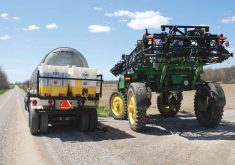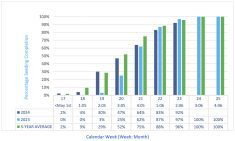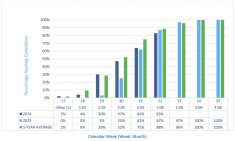Southwest Region
Thunderstorms and widespread rain events the past seven days over much of the Southwest region brought significant moisture, between 60 to 117 mm rain. These rains will not have much impact on crop yields, but some potato, corn, sunflower and a few soybean crops will still benefit, and recharge soil water reserves.
Harvest is estimated at 22% complete. Peas range from 80 to 85% complete, cereals 30 to 40% complete. Canola swathing has been started, no harvest reports yet. Yields are highly variable, but much is coming in at average to slightly below average. Harvest is stalled in most of the region due to wet weather conditions. Two to three sunny days will be required for topsoils to dry enough to support machine traffic.
Read Also

Journal pulls long-cited glyphosate study for ethics violations
The journal Regulatory Toxicology and Pharmacology has retracted a 2000 Monsanto-linked glyphosate review, drawing new scrutiny as Bayer faces mounting legal pressure.
Winter wheat and fall rye harvest are 90% complete and yields reported are average to below average with good quality. Harvest of cereal crops has begun throughout the Southwest with barley being the majority of the crop harvested. About 70% of the barley has been harvested and yields are reported to be average with good quality. Recent rains will cause downgrading effects on the remaining barley crop quality. Oats harvest 50% complete.
Spring wheat harvest progressing well with about 35 to 40% of the crop harvested with yields reported to be average with good quality, recent rains will reduce quality, increase lodging in some fields. Canola is at early seed colour change (SCC) to swath stage (60% SCC), nothing harvested yet and nothing ready for at least a week. Below average yield expected. More fields are swathed than normal, and a few are desiccated.
The soybean crop is in R6 to R7 stage. Recent rains will help in grain size and quality. Corncobs are starting to swell. Recent large rains are favoring crop weight gain; however, cool weather overnight has slowed maturity a little. Flax fields are now at the ripening and dry-down stage. There are no major disease issues, and the flax disease survey has wrapped up. Sunflowers are starting to enter R7 (flowering complete), though some are still in the R6 stage. Grasshoppers are moving from harvested crops to later maturing crops.
Recent rainfall will help rejuvenate some pastures but in most cases, it is too late and will help for next year. Rains will help dugouts and sloughs so producers may get some relief from hauling water to pastures. Producers are starting to move cattle to fall grazing and in some cases starting to prepare for cattle coming home from community pastures. Hay continues to be a huge worry for many, and prices are making it hard to secure winter feed supplies. Producers are looking at alternate feed sources nearly doubling in cost.
Northwest Region
Precipitation setting in mid-week slowed harvest progress down for most of the region. While temperatures started out high beginning of the week, cooler and wet weather set in for the remainder. Temperature high for the region was 33 C in Swan River, while the regional low reached 0°C in The Pas for a short period. With the exception of The Pas receiving minimal rain, precipitation amounts ranged from 30 mm in Swan Valley and Roblin; 91 mm in Ethelbert; and Reedy Creek receiving the most at 120 mm.
Field Pea harvest is approximately 95% complete. Yields have been lower and range from 35 to 40 bu/ac for most of the region and of average quality so far.
Spring wheat harvest slowly continued across the region, including a start in The Pas. Yields so far across and within the region have been very variable. Average yields for the region have been 40- 60 bu/ac with better fields averaging 70-80 bu/ac. Yields in The Pas averaged 80 bu/ac. Harvest progress across the region is approximately 35 to 40% complete.
Canola continues in variable staging and condition. Most of the canola is podded and ripening. Desiccation and swathing is underway as stages are reached and conditions have allowed. About 50% of the canola is rated as good, while the remainder would be fair/poor. Sunscald and heat blast is evident in most canola with the previous high temperatures.
Flax bolls are filled and crop continues to ripen. Soybeans across the region are in the R5 to R6 staging, with the southern part of the region being more advanced.
Approximately 60% of the soybean crop is rated as good condition.
Dismal hay and pasture conditions remain, particularly for much of the eastern side of the region. Beef producers continue to source feed because many hay fields will not have sufficient growth for a second cut. Once favourable weather conditions return, harvesting of annual fields for silage or greenfeed and the widespread baling of straw will resume. Additionally, ditch hay will be cut where possible. Culling of cattle herds is ongoing with animals being shipped to market. Water supply is low and many producers have been hauling water and supplemental feed to pastures.
Recent rains are helping to replenish soil moisture conditions and improve water availability and quality for livestock on pasture. The moisture is greening up pastures, however in many cases; the precipitation may be too late for additional growth. It will also aid in slowing grasshopper feeding which has been devastating to many pastures and hay fields.
Central Region
Warm and hazy conditions that started the week quickly fell to below normal temperatures as winds shifted to northerly direction and a rain shower system crossed the region bringing welcome moisture to all parts of the region. Precipitation amounts vary from 31 mm in areas along the international border to 85 mm in areas north of the TransCanada highway, while most received 40 to 60 mm. Much of this precipitation was rapidly absorbed by the dry soils. The hazy conditions of the past four weeks have cleared. Harvesting has halted since Friday, but swathing operations resumed over the weekend. Soil moisture improved significantly from the recent rains and would be considered good to even wet in some areas, but will not benefit most crops. Forecast this week is for below average temperatures and chance of showers mid to late week, which will delay a return to harvest.
Harvest of fall rye and winter wheat is considered done. Fall rye yield reports are in the 60 to 80 bu/ac range with good grain quality reported. With improved soil moisture, winter cereal planting could begin as soon as crops are harvested on fields suitable for planting.
Wheat, oats and barley came off rapidly with many fields dried down without harvest management products applied. Spring wheat harvest is most advanced in the Red River Valley but still progressing west of the escarpment with 90 to 95% done overall. Barley harvest is wrapping up with about 95% done. Whatever straw is available is being baled quickly with lots of trucks on the road moving bales. Oat harvest is also advanced with about 90% done. Oat yields vary widely from 40 to 140 bushels per acre depending on soil type and moisture conditions. T est weight reported as reasonably good, in the upper 30 lbs/bu mark. As fields are harvested, many have been harrowed and with the recent moisture, volunteer grain growth is and will be abundant. Perennial weed regrowth will also be stimulated from the recent rains and offer an opportunity to apply control measures ahead of next years growing season.
As with other crops, corn growth varies with moisture conditions. Better growing and developed cornfields are in the milk stage and filling. Recent precipitation should benefit corn crops but yield potential has already been affected by the prolonged dry conditions. Many fields in the Red River Valley in particular show evidence of severe moisture deficit and varying plant height across fields. Some fields were offered as cattle feed but there is concern with nitrates before grazing or ensiling those fields.
Canola fields harvest has begun with the earliest planted and advanced fields. Many fields are being swathed while others are left to stand for direct harvest having pod shatter resistance and/or short stature. Early reported yields range from 15 to 50 bu/ac in the south- central part of the region. Yield expectations vary greatly as some fields will be near normal having good growth while others very short, thin and poor pod development. Grasshopper feeding requiring control measures being applied to edge of fields in some locations. Heavy populations of flea beetles noticed on some later maturing stressed canola fields requiring control measures. Flax fields are turning rapidly to already ripe with harvest expected to start soon.
Soybeans are in the full seed stage (R6 to R7) with some fields starting to dry off in more stressed parts of fields. Recent precipitation is benefitting this late-maturing crop while still in the seed filling stage. Field beans in the Treherne to Portage area look good with near average yield expectations while fields in the south-central part of the region are looking fair with below average yield expectations in the 800 to 1200 lbs/acre range.
Sunflower stands are relatively short from the prolonged dry conditions. Recent rains will benefit stands with seed filling. Flowering is complete with fields in the seed filling stage (R7) with some head rot noticed.
Potato crops suffered from the hot and dry conditions, but will benefit from the recent rains and cooling temperatures. Aphid numbers remain moderately high. Some canopy breakdown noticeable as plant parts settle to the ground. Top-killing has started on seed potatoes, and direct haul of Ranger-Russet varieties has begun.
The recent rain and cooler conditions has improved crop, pasture and forage conditions. Adult grasshoppers survived the rain and continue to feed on hay & pastures. Extra straw is being baled for livestock feed. Yields range from half a bale to about 3 to 4 round bales/acre. Annual grain crops are being put to alternative use as silage and greenfeed. Second-cut alfalfa and pastures are greening up and re-growing. The hay fields and pastures that were severely moisture stressed will take longer to recover. The recent rains came early enough that it will provide pasture for fall grazing and help later crops such as silage corn, but winter feed supplies will still be short. Cattle will not require as much supplementation on pasture where forage growth was lacking. Water availability is improved but surface supply and quality is still low.
Eastern Region
At the start of the last week it was hot and dry and above seasonal for temperatures just as it had been for months. Temperatures dropped to below seasonal as rain moved into the region. The majority of the rainfall fell last Friday as thunderstorms, heavy rain and showers. Rain continued through the weekend and Monday with some sites experiencing showers until early Tuesday morning. Total rainfall amounts varied from about 33 to >60 mm with most areas getting at least 40 mm.
Because of the storms, all field activities stopped late Thursday of last week. Some standing water formed, but soaked in quickly through the very dry and hard topsoil. All producers were happy to see the rainfall. Grain growers feel it will preserve yield potential in the late season crops although it will contribute to quality downgrades in unharvested spring cereals. Livestock producers view the rainfall as beneficial to hay and pasture land recovery for next year but do not expect any benefit for this season. The rain will delay baling up of straw that was accompanying the ongoing spring cereal harvest. Insect concerns have really dropped off; insecticide pre-harvest intervals are too short to safely apply prior to harvest.
Winter wheat and fall rye harvest is completed. Winter wheat yield reports varied from 50 to 80 bu/acre on whole field basis with light soil areas doing as low as 30 bu/acre. Good seed quality and test weight were noted. Fall rye yields were highly variable in fields in correlation with soil types. Yields ranging from 50 to 90 bu/ac across fields with whole fields averaging out in that 70 to 80 bu/ac range.
Spring wheat harvest continued this past week with good progress made before the rain with an estimated 85% of acres harvested. Yield reports ranged from 45 to 70 bu/ac with reports indicated good quality and bushel weights. Wheat proteins ranging from 10.5 to just over 14%. Producers reporting that many buyers have implemented protein discounts. Oat yields are still disappointing overall, yield reports ranged from 50 to 100 bu/ac with 70 bu/ac averages with light bushel weights. Oats harvest progress estimated at 85% complete. Some 40lb bushel weights now showing up after lots of early 37lb samples.
Limited canola harvest has begun, estimated at 10% complete for the region. A significant amount of pre- harvest desiccation occurring prior to rain delays. Canola is ripening and drying down fast. A few early seeded fields have been harvested, some of those were swathed. Lots will be ready for straight cutting once things dry out. Early yield reports range from 15 to 25 bu/acre. Producers are expecting lower than normal yields. Early quality reports appear to be good.
Flax continues to ripen and dry down. Below average yield expected given how poorly the crop handled drought stress. All stands have areas that simply dried out instead of completing filling and going through a regular maturity process.
Soybeans are now at R6 (full pod) with some fields of very early varieties having plants in R7 (at least one brown pod on plant). Signs of wilting dry down have gone away. Soybeans are starting to exhibit leaf yellowing. Very early season varieties are starting to show some yellow and the occasional brown pod. Soybean maturity seems to be moving along more normally in northern districts as opposed to drier areas where maturity, particularly amongst very short-to-very short season varieties is proceeding at a rapid pace. With the rain this past week, producers are watching the final pods plants initiated to see if they will survive and fill.
Sunflower are at R6 (flowering complete and ray flowers wilting) to R7 (back of head is yellowing). Crop condition still looks good overall. Concern has being expressed about variability in head sizes in the crop. Rainfall will work to preserve yield potential in the crop.
Corn drought stress symptoms have disappeared. Producers are hopeful that the rain will help in the grain filling process. However, expectations for corn crop are for below average yields.
Hay and pasture situation remains unchanged. Rainfall will help recharge soil moisture for next year. Second cut beef hay still ongoing; while both dairy and beef producers will wait to see if third cut opportunities come. Producers continue to work at making sure they secure enough feed one way or another, meaning lots of dropped straw being baled, greenfeed opportunities were taken and more grain corn went for silage. Some suffering canola crops were silaged in some cases. Livestock water availability is rated as adequate because producers have implemented a variety of measures to deal with the situation.
Interlake Region
Intense rainfall over the northern Interlake this past week brought amounts up to 95 mm at Moosehorn, and a low of 47 mm at Selkirk. High amounts of rainfall moved the percentage season accumulation of rainfall from 54 to 80% of normal at Eriksdale, in one instance, an increase of 26% of normal growing season rainfall in one week. This was very similar for many other locations in the Interlake.
Rainfall has generally been too late for any grain crops, excepting some soybeans and corn, which may help increase pod fill and tonnage. Harvest operations are expected to resume in many areas by the weekend, pending a favourable forecast. Soil testing has begun, since soil moisture is more favourable to probing, and results are showing a significant increase in the number of fields with high residual nitrate levels, even finding undissolved granular fertilizer in probe points in a few instances.
Spring cereal harvest sits at just over 75% complete, with many areas over 90% done. Yields are below average for all crops. Wheat yields range from 20 to 60 bu/acre, averaging between 35 to 40 bu/acre. Quality of grain harvested prior to the preceding weeks rain was graded #1 milling quality. It is expected that much of the unharvested crop to date will be feed quality.
Oats are typically yielding 50 to 80 bu/ac in the south Interlake area; most oats is lightweight. Many oat crops were already cut and baled off for greenfeed. Barley has been yielding between 20 to 80 bu/ac, averaging mid-40’s.
Cereal straw is in high demand, and all straw is being dropped and baled behind combines and harvest progresses.
The earliest canola crops are yielding between 5 to 25 bu/ac, averaging between 10 to 15 bu/acre. Grasshopper damage has been higher than expected, and producers saved costs on insecticide given the poor crop yield outlook.
Grain farmers are expected to resume harvest operations shortly, given how dry soils were. Many farmers are facing additional stresses of buying out grain contracts where yields were dramatically less than normal, and facing stiff buyout penalties.
Cattle ranchers are benefitting from the rainfall the most, with a chance for forages and pasture to store some moisture, and perhaps resume a little growth for fall grazing. Water supplies remain very low, but have improved somewhat, though surface water quality remains poor.














